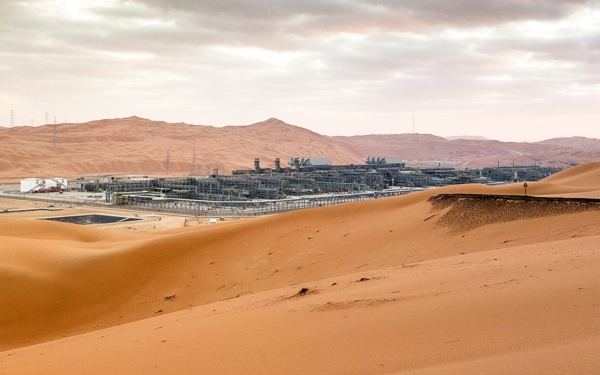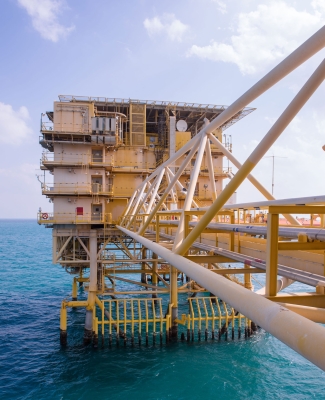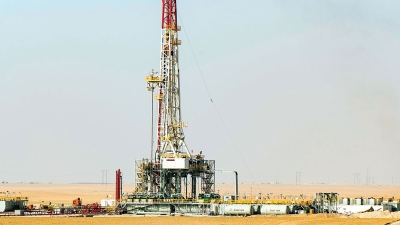

The Shaybah Oil Field is one of the large oil fields in the middle of ar-Rub' al-Khali (Empty Quarter) desert in the Kingdom of Saudi Arabia. The story of the field, located eight hundred km south of Dhahran, dates back to 1938 when a team from Saudi Aramco visited ar-Rub' al-Khali desert for the first time to explore the possibility of finding underground oil reserves there.
Discovery of oil in Shaybah Field
Oil was discovered in the Shaybah area during the drilling of the exploratory well "Shaybah 1" in 1968. The oil is of the Arabian Super Light type, but it was held as a reserve until 1995.
Work began in the Shaybah field under complex conditions. The exploration efforts resulted in the discovery of a vast oil field surrounded by red and golden sand dunes that are one thousand ft (333 m) high and subjected to winds reaching speeds of eighty km per hour (fifty mi per hour). Summer temperatures can reach up to 122°F (fifty °C). The terrain, climate, and logistical complexities posed significant obstacles to development efforts, resulting in the field remaining undeveloped for another thirty years.
Exploration efforts and challenges continued, and after developing ideas, strategies, and project designs, construction began in 1995. The work included moving about thirteen million m of sand, building a 386 km road through the desert, constructing a fully operational airport, and laying a 645 km pipeline extending to processing facilities in the north. Additionally, 145 wells were drilled, and three gas-oil separation plants were established.
By 1998, through perseverance, commitment, and determination, Saudi Aramco overcame enormous obstacles and completed the entire project a year ahead of schedule. The project took fifty million man-hours and involved moving about thirteen million m of sand. The reserves of the Shaybah field alone could supply the world's oil needs for more than 160 days and supply Europe for more than two years.
The first phase of the Shaybah field
The success of the project was not only due to the vast reserves. Saudi Aramco recognized that Shaybah's potential exceeded what had already been utilized. Therefore, the company embarked on two new projects: the Shaybah oil field expansion project and the natural gas liquids (NGL) recovery project.
The implementation of the first phase of the Shaybah oil field expansion project led to an increase in production to 750,000 bbl per day of high-value Arabian light crude oil by 2009. However, the company's ambitions were greater than that. In 2016, the company boosted its production by an additional 250,000 bbl, increasing the total production capacity of the Shaybah field to one million bbl per day, effectively doubling the initial production capacity.
Production capacity of the Shaybah Field
Given its remote location, the Shaybah field facilities include a dedicated natural gas liquids (NGL) recovery unit, an airport, and employee housing. The field was developed using advanced methods such as three-dimensional seismic imaging and multi-lateral horizontal well drilling. Processing facilities were added in stages as production data became available.
The Maximum Sustainable Capacity (MSC) of the Shaybah field was estimated on December 31, 2018, at one million bbl of crude oil per day. Its proved reserves amounted to 14.86 billion bbl of oil equivalent, including 13.62 billion bbl of liquid reserves.
The gas production capacity at the Shaybah field is used for natural gas liquids (NGL) extraction and does not supply the main gas network with natural gas. Since 1998, the company has expanded its production capacity of Arabian Super Light crude oil extracted from the Shaybah field from five hundred thousand bbl per day to one million bbl per day in 2016.
Expansion of the Shaybah field
The Shaybah crude oil field expansion project included the expansion of existing facilities at Gas-Oil Separation Plants (GOSPs) one, three, and four. Since GOSP four would handle a significant portion of the additional crude oil production, these plants saw the addition of four gas-oil separation units, a series of wet crude handling units, loading and unloading pumps, transportation pumps, twenty-three intermediate units to increase gas pressure, seven natural gas drying units, along with other associated facilities.
The expansion included the construction of additional facilities for transporting crude oil and associated infrastructure at GOSP one and GOSP three. This expansion contributed to increasing the capacity to 4,400 million standard ftper day of associated gas, which positively impacted the production capacity of the Arabian Super Light crude oil at all GOSPs in Shaybah.
The natural gas liquids (NGL) recovery project also includes facilities for extracting high-value NGLs in Shaybah. This entails the construction of a new NGL recovery plant with a processing capacity of 2.4 billion standard ft to extract the equivalent of 275,000 bbl per day of NGLs containing methane and heavier elements from the produced gas. The project also involves recompressing the lighter gas and reinjecting it into the reservoir. The project provides large quantities of ethane, which is one of the most important types of gas for industrial development, in addition to other natural gas liquids.
The Shaybah field project includes the construction of facilities and units for handling and purifying gas, as well as extracting natural gas liquids (NGLs). It also involves a project for water removal, gas compression (both recycled and sour gas), and NGL storage and shipping. Additionally, the project aims to enhance gas handling facilities at the four Gas-Oil Separation Plants (GOSPs) in Shaybah. The project includes the construction of facilities for both electrical and non-electrical utilities, two gas processing units, units for NGL extraction and removal of carbon dioxide and hydrogen sulfide, and a 638 km pipeline network with a diameter of thirty-six in to connect these facilities to the existing NGL pipeline network near the Abqaiq plants.
Attempted attack on the Shaybah field
In 2019, Saudi Aramco's natural gas liquefaction facility in Shaybah was targeted by five unidentified drones, resulting in fires and damage to the facility's processing and dual production infrastructure. The attack triggered the company's emergency response and business continuity protocols, including stopping feedstock flows, depressurizing and shutting down equipment, assessing the facility's risk, and safely resuming operations. No injuries or fatalities were reported as a result of the incident. The facility's operations were restored on a single natural gas liquefaction train within two weeks of the attack.
The Shaybah Wildlife Sanctuary
Shaybah includes a fenced wildlife reserve, which is affiliated with Saudi Aramco, and it covers an area of 637 km². Within the reserve, there are ten endemic Arabian species, and thirty-nine species listed on a national list that includes fifty species with high conservation priority. Additionally, thirteen species are regionally threatened with extinction. Biodiversity surveys have shown the presence of eleven species of native plants, thirteen potential species of reptiles, eighteen species of mammals, and 176 species of birds, including 169 migratory species.
Distinguishing features of Shaybah field operations
The Shaybah project won the Gulf Cooperation Council (GCC) Environmental Excellence Award in 2011 for its use of zero gas flaring technology, wastewater recycling, emissions capture, and wildlife protection. Given that the area surrounding the field is home to more than seventy sand gazelles and forty Arabian oryx, the company has taken exceptional measures to ensure the preservation of their natural habitat.
In 2019, the Shaybah Wildlife Sanctuary underwent an external audit and received the ISO 9001 certification for quality management standards. Additionally, the Shaybah production management received the President's Award for Environmental Preservation twice. In 2010, it won the award for the Best Environmentally Friendly Industrial Facility among GCC countries, and in 2018, it received the Saudi Aramco President's Award for Excellence.
Related quizzes

